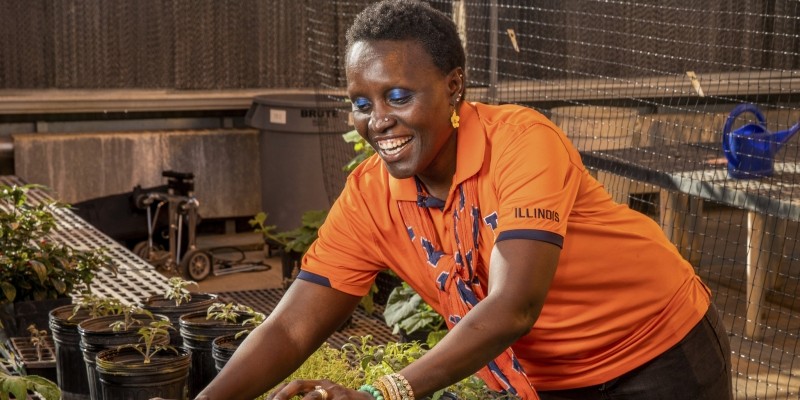You’ve heard of synesthesia, right? It’s that phenomenon where stimulation of one sense triggers another. People hearing color and so on. Smelling flowers and cut grass isn’t exactly like that for most of us, but when we smell vegetal scents, we’re actually hearing intimate conversations between plants and the world around them.
That’s according to Esther Ngumbi, an assistant professor of entomology and African American studies at U of I and our guest for this edition of “Peering into the Ivory Tower.”
“I always say just stop for a moment and listen carefully,” she says, pausing to take a deep sniff. “You’ll hear all these conversations that are happening in the trees and the plants that surround you. It may be a cry for help, it may be a cry to say, ‘Hey, I’m thirsty.’
“Plants may not walk, they may not move, but they use other means to meet their needs. We have evidence that chemistry mediates a lot of the interactions that are going on above and below ground.”
Plants release volatile organic compounds and other signaling chemicals at the lightest touch — the soft pad of an insect’s foot will do it.
“Say a caterpillar or a moth touches the surface of a plant. Millions of years of evolution trigger reactions within the plant so it’s like, ‘Okay, somebody has landed on me. Is it an enemy? Is it a pollinator?’ Biochemical cascades start happening immediately,” Ngumbi explains. “And within hours, we have chemistry, parcels of perfume the plant releases, to say, ‘Hey, I’m in danger, somebody’s eating on me. Do I have a rescuer around me?’”
The rescuers in this case are pest insects’ natural enemies such as parasitoids, small insects that seek out and kill the bugs pestering plants. But in other cases, plants call soil bacteria or fungi to help them maximize nutrient or water uptake. Plant signals can also convey messages to other plants. For example, some types of trees signal their neighbors to ramp up production of defense chemicals when herbivorous insects attack.
It’s a complex and interconnected symphony scientists are only beginning to understand and appreciate. And here we thought flowers just smelled nice.
Ngumbi isn’t motivated to identify these chemical signals for curiosity’s sake alone. Instead, she recognizes their potential role in improving agriculture and the industry’s sustainability both here and in her home country, Kenya.
First, by deploying smart sensors that can detect crops’ chemical signals, farmers could better understand what’s happening in the field at any given moment. Then, instead of irrigating or spraying pesticides on vast acreages, they could target only those areas showing signs of drought or pest-induced stress.
“Imagine sitting in the comfort of your room, watching real-time information coming in through sensors, through chemistry. Rather than coming to your field when it’s too late or applying water or fertilizers to everything, you could notice when one section of your farm is producing these compounds, telling you the crops need water there,” Ngumbi says. “As we incorporate chemistry, we can really reduce the overall use of inputs like fertilizers and pesticides.”
Unfortunately, Ngumbi says many crops have forgotten how to call for help. Breeders have spent the last century working to maximize crop yield, with helpful chemical signals ending up on the cutting room floor. Reintroducing these signals could call back natural pest predators, reducing the need for pesticides, as well as soil microbes that could help plants access nutrients and water in the soil, decreasing use of irrigation or fertilizers.
In Kenya, where Ngumbi works with smallholder farmers, the chemical conversation is still lively.
“In Africa, we have perfected growing maize and intercropping with plants that repel insect pests. And then on the border, we plant crops that attract pests’ natural enemies. So we have shown it is possible to design your farm in a way that really uses chemistry to your advantage,” she says.
Could it work here? It’s hard to imagine the vast, homogeneous fields of the Corn Belt incorporating the diversity necessary to become self-sustaining systems fueled by plant chemistry. But Ngumbi points to some hopeful signs.
“Farmers are slowly beginning to incorporate pollinator strips. In the future, these pollinator strips could also bring in plants using chemistry to concentrate natural enemies. This would give other benefits of chemistry to the farmer,” she says. “That’s how I see working with the systems that are currently being used and that farmers accept, and then beginning to layer up these concepts.”
Tuning the agriculture industry into the chemical conversation may take awhile, but for the rest of us, it’s as easy as taking a deep breath on a spring day. The magnolias and cherry trees are calling pollinators especially loudly at the moment. And next time you fire up the lawn mower, you’ll hear your grass calling out for help. Just listen. Just breathe.
To learn more about Ngumbi’s work, visit her website.








